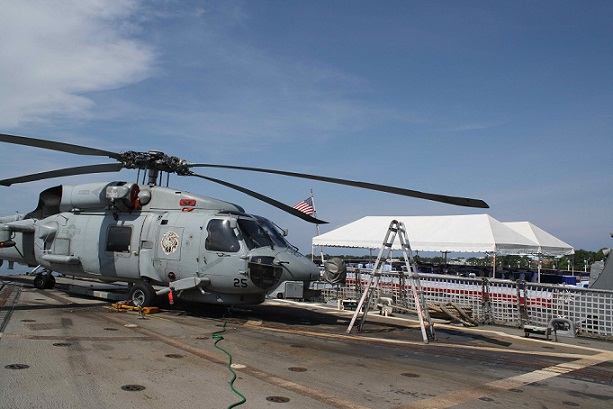
An anti-submarine helicopter on the flight deck of USS Howard, a missile-guided destroyer that participated in the PH-US military exercise
Thomas said: “We are allies. We will continue to work with each other in all issues including the South China Sea and Spratlys.” This was at the time when the Philippines was protesting the intrusions of Chinese armed vessels in West Philippine Sea.
Thomas got hearty applause when he repeated that assurance during the launching of the National Renewable Energy Program at the Department of Energy in the presence of President Aquino.
Thomas also said that the US stands “by our commitment under Mutual Defense Treaty.”
What’s the US commitment under the 1952 RP-US MDT?
Article IV of the MDT says, “Each party recognizes that an armed attack in the Pacific area on either of the Parties would be dangerous to its own peace and safety and declares that it would act to meet the common dangers in accordance with its constitutional processes.”
Former UP College of Law Dean Pacifico Agabin said “constitutional processes” means the US president must first consult with Congress before coming to aid of the Philippines in case of hostilities in the South China Sea.
In other words American lawmakers, in the spirit of democracy, would be discussing whether it is in the interest of the American people to risk their troops in the South China Sea while the Philippine Navy with their vintage vessels battles the well-equipped Chinese troops.
But the Spratlys tension could pave the way of the return of American troops in the Philippines.
In the recent visit of Foreign Secretary Albert del Rosario to Washington D.C, State Secretary Hillary Clinton said “The US is determined and committed to supporting the defense of the Philippines, and that means trying to find ways of providing affordable material and equipment that will assist the Philippine military to take the steps necessary to defend itself.”
As if on cue, last Tuesday, Philippine Navy Vice Commander Rear Admiral Orwen Cortez told a press conference following the opening ceremony of the PH-US Cooperation Afloat Readiness and Training (CARAT) in Puerto Princesa of a plan enter into an “operational lease” agreement with the US military.
In a report by VERA Files, the “operational lease” is being resorted to as a short cut because “the government could not purchase patrol boats off-the-rack, and would have to wait two years to procure them, given government procurement rules. ”
VERA Files quoted Cortez as saying that the operation lease concept was practiced in the 50’s under the Southeast Asia Treaty Organization (SEATO).
SEATO was a regional alliance formed in 1955 to contain the powers of communist China by providing for the collective defense of its members. But it only had two Southeast Asian members, Philippines and Thailand, and the latter hosted the headquarters. The other members were Australia, France, New Zealand, Pakistan, the United Kingdom and the U.S. SEATO formally disbanded in 1977.
A reflection of the geo-political changes, the Association of Southeast Asian Nations now groups former SEATO members with Vietnam, the communist country that humbled the mighty America.
But, we have a question: under the lease agreement, who will operate the U.S. vessels?
It was fine during the SEATO days because the Philippines was hosting American bases under the RP-US Military Bases Agreement.
But as the VERA Files article said, “should the country enter into a lease with the U.S. that would include American military personnel who will help operate the vessels, the arrangement might violate the Constitutional ban on foreign military troops.”
Article 18, Section 25 of the Constitution provides that “After the expiration in 1991 of the Agreement between the Republic of the Philippines and the United States of America concerning Military Bases, foreign military bases, troops, or facilities shall not be allowed in the Philippines except under a treaty duly concurred in by the Senate and, when Congress so requires, ratified by a majority of the votes cast by the people in a national referendum held for that purpose, and recognized as a treaty by the other contracting state.”
Besides, isn’t the Aquino government reviewing the RP-US Visiting Forces Agreement?












